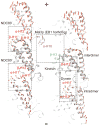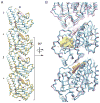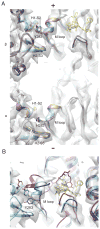High-resolution microtubule structures reveal the structural transitions in αβ-tubulin upon GTP hydrolysis
- PMID: 24855948
- PMCID: PMC4054694
- DOI: 10.1016/j.cell.2014.03.053
High-resolution microtubule structures reveal the structural transitions in αβ-tubulin upon GTP hydrolysis
Abstract
Dynamic instability, the stochastic switching between growth and shrinkage, is essential for microtubule function. This behavior is driven by GTP hydrolysis in the microtubule lattice and is inhibited by anticancer agents like Taxol. We provide insight into the mechanism of dynamic instability, based on high-resolution cryo-EM structures (4.7-5.6 Å) of dynamic microtubules and microtubules stabilized by GMPCPP or Taxol. We infer that hydrolysis leads to a compaction around the E-site nucleotide at longitudinal interfaces, as well as movement of the α-tubulin intermediate domain and H7 helix. Displacement of the C-terminal helices in both α- and β-tubulin subunits suggests an effect on interactions with binding partners that contact this region. Taxol inhibits most of these conformational changes, allosterically inducing a GMPCPP-like state. Lateral interactions are similar in all conditions we examined, suggesting that microtubule lattice stability is primarily modulated at longitudinal interfaces.
Copyright © 2014 Elsevier Inc. All rights reserved.
Figures







Comment in
-
The engine of microtubule dynamics comes into focus.Cell. 2014 May 22;157(5):1008-10. doi: 10.1016/j.cell.2014.05.001. Cell. 2014. PMID: 24855939
References
Publication types
MeSH terms
Substances
Associated data
- Actions
- Actions
- Actions
Grants and funding
LinkOut - more resources
Full Text Sources
Other Literature Sources

